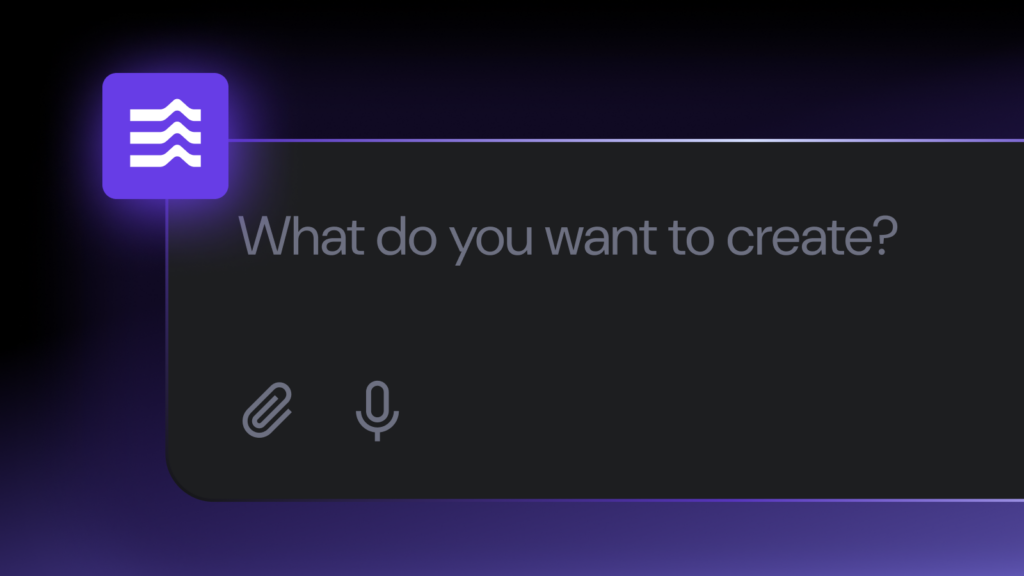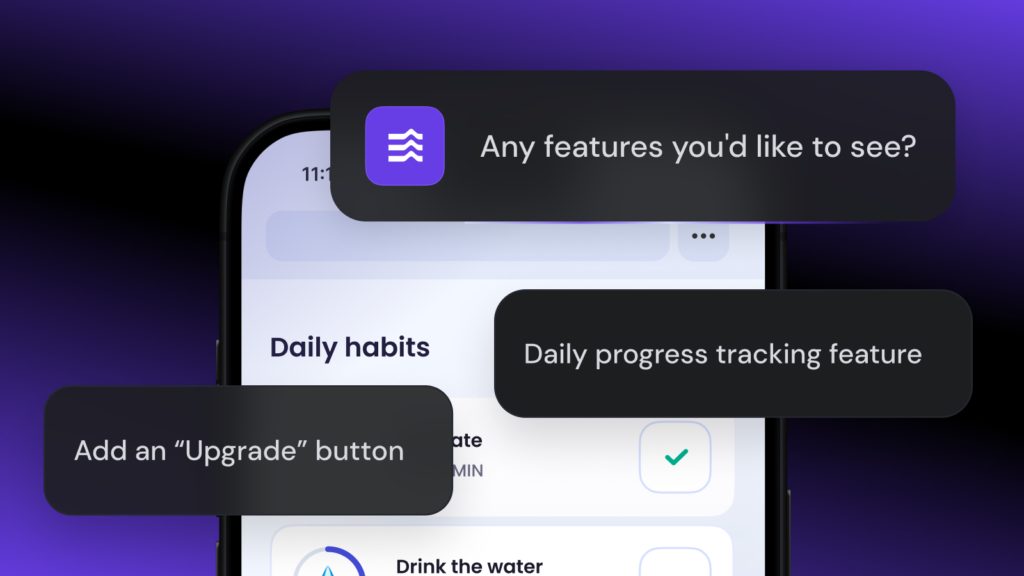10 best v0 by Vercel alternatives to build web apps
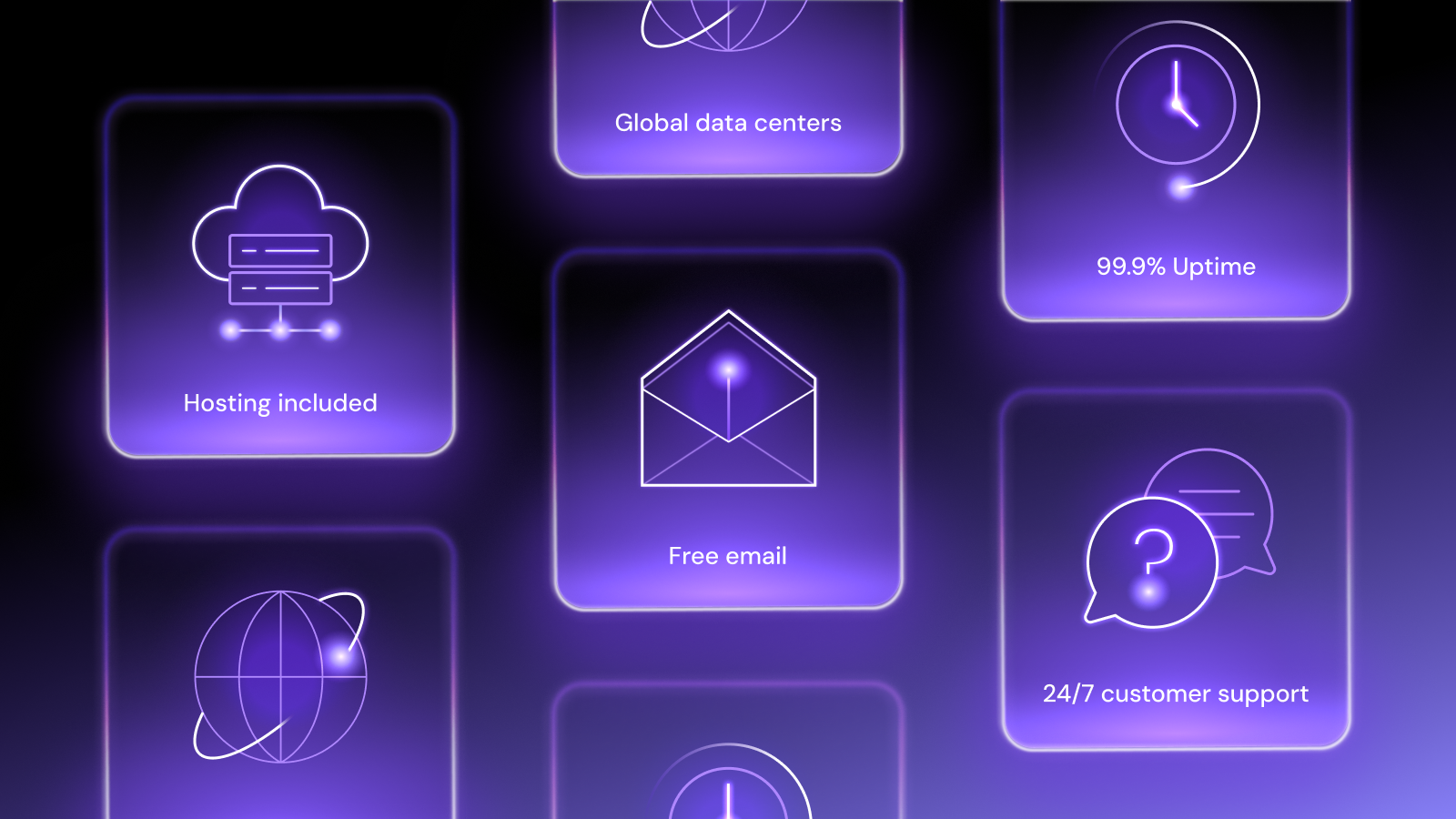
v0 by Vercel is an AI tool that turns natural language prompts into production-ready React and Tailwind CSS code. It streamlines the process of building user interfaces and frontend components.
While v0 offers fast prototyping, you might look for alternatives due to its limited customization options and reliance on specific UI libraries.
This article covers the best v0 by Vercel competitors – from all-in-one AI builders to advanced coding assistants. We’ll highlight their key strengths, unique features, and pricing models to help you choose the right fit for your next project.
A quick comparison of the best v0 alternatives
Here’s a quick look at the top v0 alternatives, comparing their pricing models, standout features, and ideal use cases.
| Tool | Pricing | Key features | Best for |
| Hostinger Horizons | From $19.99/month – free trial available | AI web app development tool, real-time editing, hosting integration, voice/image inputs, multilingual support | Non-technical users building web apps quickly with AI and built-in hosting |
| GitHub Copilot | From $10/month – free plan available | AI code suggestions, natural language to code, multi-language support, IDE integration | Developers who want AI assistance directly in their coding environment |
| Replit | From $30/month – free plan available | Browser-based IDE, Replit Agent, instant deployment, real-time collaboration | Teams or solo devs building full-stack apps entirely in the browser |
| Netlify | From $19/member/month – free plan available | Static site hosting, serverless functions, global CDN, form and identity tools | Frontend-focused teams deploying modern Jamstack or static websites |
| Firebase | Pay-as-you-go – free plan available | Realtime database, authentication, cloud messaging, analytics, seamless scaling | Dev teams needing scalable backend services with minimal setup |
| Fly.io | Pay-as-you-go | Edge deployment, persistent storage, Postgres support, custom networking | Developers deploying full-stack apps close to users with low latency |
| Bubble.io | From $29/month – free plan available | No-code builder, visual editor, workflow automation, database and API tools | Non-technical founders launching MVPs with drag-and-drop tools |
| Lovable | From $20/month – free plan available | Prompt-based app builder, full-stack generation, Supabase & GitHub integration | Solo builders or teams turning prompts into full-stack apps |
| Motiff | From $4/month – free plan available | AI design tools, design system manager, Dev Mode, prototyping, collaboration | Designers and teams creating UI workflows with AI and smooth dev handoff |
| Cursor AI | From $20/month – free plan available | AI code editor, natural language commands, multi-file support, terminal integration | Dev teams seeking an AI-enhanced VS Code experience |
Top 10 v0 alternatives
Now, let’s take a closer look at each v0 alternative. We chose these tools based on several factors: ease of use, pricing flexibility, and feature set.
Whether you’re building solo or with a team, you’ll find options matching different experience levels and technical needs.
Hostinger Horizons

Best for: Entrepreneurs, small businesses, and individuals looking to build web apps quickly without technical expertise.
Pricing: Starts at $19.99/month (free trial available).
Hostinger Horizons is an AI app builder that takes you from raw concepts to fully functional web apps without writing a single line of code.
Simply describe your app idea through a chat interface, and the platform’s AI assistant will generate, customize, and publish it in real time.
Compared to v0, Hostinger Horizons offers a more complete, all-in-one solution. It generates web apps and includes built-in hosting, domain registration, and email services – minimizing the need for third-party tools.
You can also connect your app to Supabase to enable dynamic data processing and storage.
Key features:
- AI-powered development – describe your app idea, and the AI builds it for you.
- Real-time editing – make changes on the fly with instant previews.
- Voice and image inputs – interact with the AI using voice commands or visual prompts.
- Multilingual support – build web apps in over 80 languages.
- Integrated hosting and domain services – launch your app with one click; no external services needed.
Pros:
- No coding skills required.
- All-in-one platform with hosting and domain.
- User-friendly interface, ideal for beginners.
- Various plans with up to 1,000 AI messages/month.
Cons:
- You can’t view or modify the underlying code within the Hostinger Horizons interface.
- Hosting and deployment are tied to Hostinger’s ecosystem unless you export your app for external use or advanced customization.

GitHub Copilot

Best for: Developers seeking an AI coding assistant to boost productivity and code quality within their existing environment.
Pricing: Starts at $10/month (free plan available).
GitHub Copilot is an AI-powered coding assistant developed by GitHub in collaboration with OpenAI. It integrates directly into popular code editors like Visual Studio (VS) Code and JetBrains IDEs.
Using GitHub Copilot, you can receive context-aware code suggestions, generate entire functions, and convert natural language prompts into code.
While v0 focuses on turning prompts into complete UI components, GitHub Copilot supports you throughout development, boosting productivity and reducing the need to consult documentation.
Key features:
- AI-powered code completion – analyzes your code and comments to offer accurate suggestions.
- Natural language to code – converts prompts into code snippets across multiple languages.
- Context-aware suggestions – adapt to your current codebase for smarter completions.
- Seamless IDE integration – works smoothly with VS Code, Visual Studio, and JetBrains IDEs.
Pros:
- Speeds up development by reducing repetitive coding.
- Helps you learn by providing examples and suggestions.
- Supports a wide range of languages and frameworks.
- Improves code quality by recommending best practices.
Cons:
- Occasionally suggests incorrect or inefficient code, requiring review.
- Can encourage over-reliance, especially for new developers.
- Limited support for less common languages and frameworks.
Replit

Best for: Developers and teams needing an all-in-one, browser-based environment to build, deploy, and scale apps with AI assistance.
Pricing: Starts at $30/month (free plan available).
Replit is a cloud-based development platform that lets you write, run, and deploy code directly from your browser.
It supports over 50 programming languages and offers real-time collaboration, making it a solid choice for solo developers and teams.
With features like Replit AI (formerly Ghostwriter) and Replit Agent, you can generate code from simple prompts and debug faster, speeding up your development workflow.
Replit offers a complete development experience – combining AI assistance, version control, and deployment in one place, making it a strong alternative to v0.
Key features:
- Replit Agent – generate, debug, and explain code with AI-powered suggestions.
- Real-time collaboration – work simultaneously with others in the same codebase.
- Integrated deployment – launch apps directly from the IDE without external tools.
- Multi-language support – code in over 50 languages, including Python, JavaScript, and Go.
- Version control – built-in Git integration for seamless code management.
Pros:
- No setup required; start coding instantly from any device.
- Complete toolset for full-stack development in the browser.
- Active community and rich learning resources.
Cons:
- Performance may vary depending on project size and browser limitations.
- Key features like Replit Agent and Private Repls are only available on paid plans.
Suggested reading
Read our article on Replit alternatives to see how it compares to platforms like Glitch and PaizaCloud.
Netlify
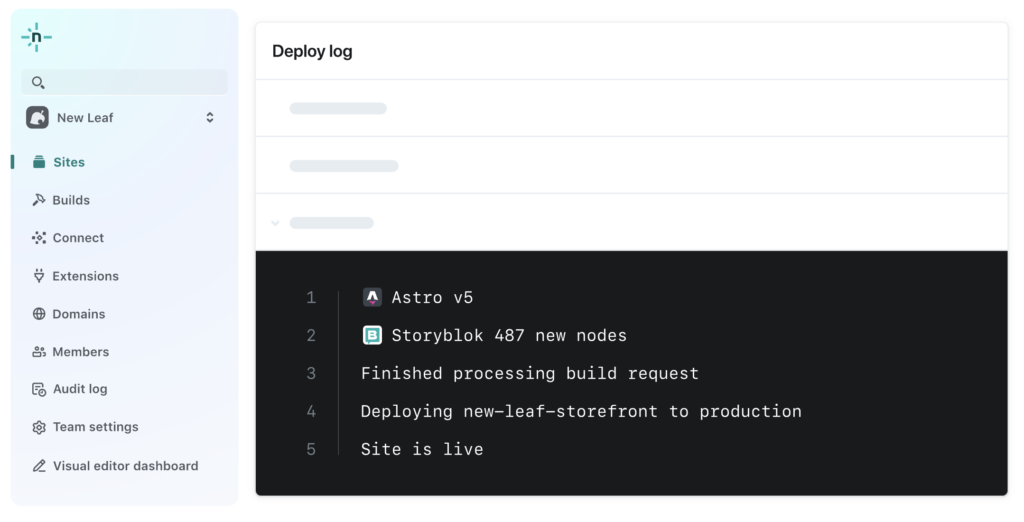
Best for: Developers and teams building static or Jamstack websites with tools like forms, identity management, and A/B testing.
Pricing: Starts at $19/member/month (free plan available).
Netlify is a cloud-based platform that simplifies building, deploying, and managing modern web projects.
It supports many frameworks and includes built-in features like form handling, identity management, and split testing.
Getting started with Netlify is easy. Connect your Git repository, and Netlify will automatically build and deploy your site.
You can then set up serverless functions, configure environment variables, and take advantage of its global content delivery network (CDN) with minimal setup.
Key features:
- Continuous deployment – automatically builds and deploys sites from Git repositories.
- Serverless functions – adds backend functionality without server management.
- Global CDN – delivers content quickly to users around the world.
- Built-in form handling – captures form submissions with no extra code.
- Identity management – handles user authentication and access control.
Pros:
- Streamlines development with integrated tools like deploy previews, edge functions, and A/B testing.
- Offers a generous free tier for hobbyists and personal projects.
- Supports many frameworks, including Next.js, Gatsby, and Hugo.
Cons:
- Some users report slow build times and unclear error messages in logs.
- Lacks native backend and database hosting, requiring third-party services for dynamic features.
- The per-member pricing model is complex, making costs harder to predict as teams grow.
Firebase
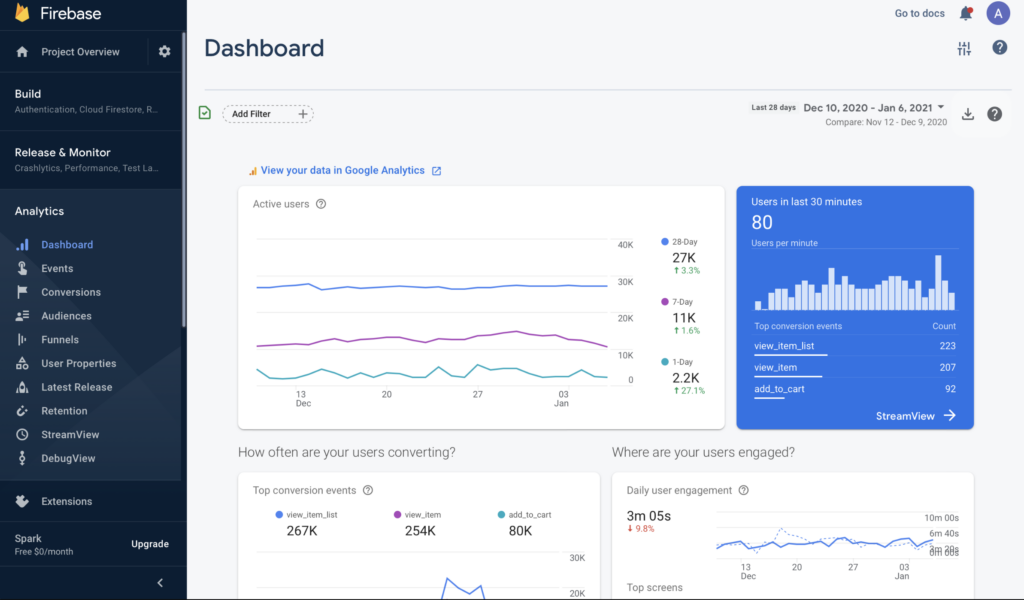
Best for: Developers looking for a complete backend-as-a-service (BaaS) platform with real-time databases, authentication, and analytics.
Pricing: Pay-as-you-go (free plan available).
A cloud-based platform developed by Google, Firebase offers a suite of tools for building and managing web and mobile apps.
Unlike v0, which focuses on frontend development, Firebase provides a complete backend solution. It lets you build and scale apps without managing server infrastructure and integrates seamlessly with other Google Cloud services.
Firebase’s real-time database and Firestore support dynamic data syncing, while built-in authentication and analytics tools simplify user management and performance tracking.
To get started, you can use the free Spark plan, which includes basic features. When you’re ready to scale, upgrade to the Blaze plan with flexible, pay-as-you-go pricing.
Key features:
- Real-time databases – Firestore and Realtime Database for syncing dynamic data.
- Authentication – supports email/password, phone, and third-party logins.
- Cloud messaging – Firebase Cloud Messaging (FCM) for push notifications.
- Analytics – built-in integration with Google Analytics for Firebase.
Pros:
- Complete suite of backend services.
- Seamless integration with Google Cloud tools.
- Flexible pricing means you pay only for the features you use.
- Extensive documentation and developer support from Google.
Cons:
- The NoSQL structure may not work well for every data model.
- Limited support for complex queries compared to relational databases.
- While flexible, the pricing can be confusing due to separate charges for each feature.
Fly.io
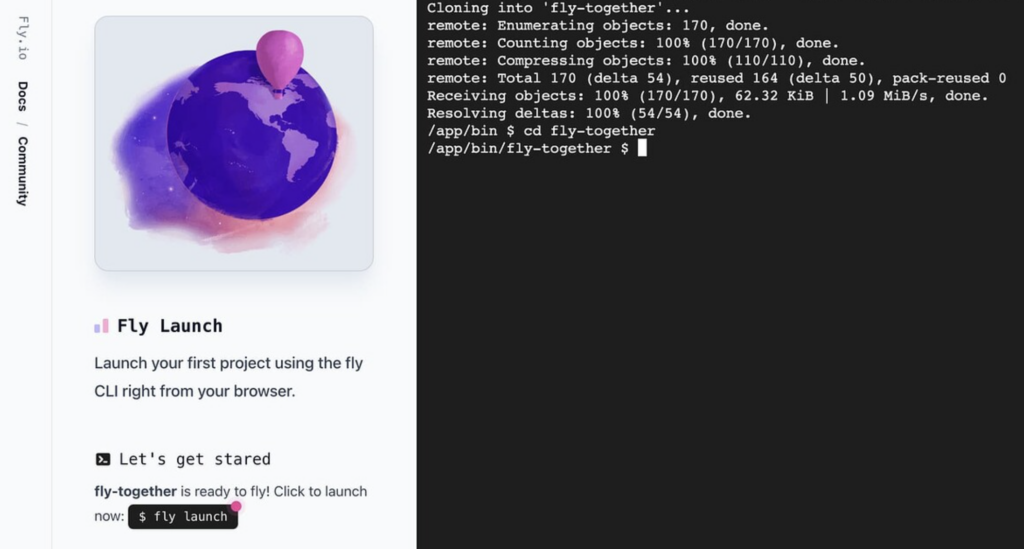
Best for: Developers and teams wanting to deploy full-stack apps globally with low latency and minimal infrastructure management.
Pricing: Pay-as-you-go.
Fly.io is a cloud platform that runs apps close to users by deploying them across a global network of servers.
It focuses on edge computing, letting you host apps in multiple regions worldwide to reduce latency and improve performance. You can also deploy your apps in Docker containers or Firecracker micro-VMs.
Fly.io gives you control over persistent storage, custom networking, and support for multiple programming languages. This makes it an excellent choice for apps that need specific configurations or stateful services.
Key features:
- Global deployment – run apps close to users in multiple regions to reduce latency.
- Persistent storage – attach volumes to apps to retain data.
- Built-in Postgres – deploy managed PostgreSQL databases with high availability.
- Custom networking – configure private networks and custom domains.
- Flexible runtimes – supports various languages and frameworks like Node.js, Go, and Ruby.
Pros:
- Delivers low-latency global performance without complex infrastructure setup.
- Provides detailed control over app environments and deployment.
- Transparent, usage-based pricing model.
Cons:
- Has a steeper learning curve than traditional platform-as-a-service (PaaS) options.
- No built-in frontend tools – you’ll need to set up frameworks manually.
- Some users may find region-based pricing less appealing.
Bubble.io

Best for: Entrepreneurs, startups, and non-technical users aiming to build full-featured web apps without coding.
Pricing: Starts at $29/month (free plan available).
Bubble.io is a no-code development platform that empowers users to design, build, and launch web apps through a visual interface.
It offers an all-in-one solution that covers frontend design, backend logic, workflows, and database management.
With Bubble, you can create responsive web apps by dragging and dropping elements, setting up workflows, and integrating with external APIs – all without writing a single line of code.
This makes it an excellent choice for quickly prototyping ideas or launching minimum viable products (MVPs).
Key features:
- Visual editor – design user interfaces using a drag-and-drop builder.
- Workflow automation – define app logic without writing code.
- Database management – build and manage your database within the platform.
- API integrations – connect your app with third-party services and APIs.
Pros:
- Speeds up development with pre-built templates and components.
- Built-in responsive design ensures apps work well across devices and screen sizes.
- The free plan has enough features to build and test MVPs or early-stage projects.
Cons:
- Apps are tied to Bubble.io’s proprietary platform, making migrating or exporting code difficult.
- Despite offering responsive design, it still lacks native mobile development support.
Lovable
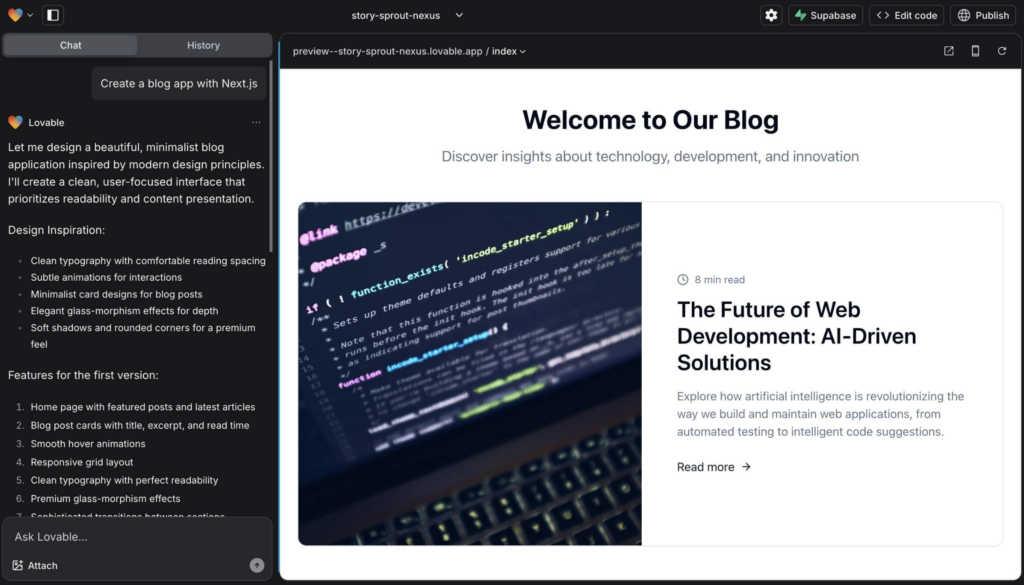
Best for: Non-technical founders and solopreneurs who want to build full-stack web apps quickly using simple prompts.
Pricing: Starts at $20/month (free plan available).
Lovable is an AI-powered no-code tool that lets you design, build, and deploy web apps through a conversational interface by describing your idea in natural language.
You start by entering a prompt detailing your app concept. Lovable then generates a functional web app; you can refine it further with follow-up prompts.
The platform integrates with tools like Supabase for backend services and GitHub for version control. It also offers one-click deployment, so you can launch your app without dealing with server setups or infrastructure.
Key features:
- Natural language to app generation – build web apps by describing them in everyday language.
- Full-stack development – includes frontend, backend, and database functionality.
- Supabase integration – connect seamlessly for data storage and backend logic.
- GitHub synchronization – sync projects with GitHub for version control.
- One-click deployment – launch your app without manual configuration.
Pros:
- User-friendly interface for non-coders.
- Offers flexibility with code ownership so that you can customize the output.
Cons:
- Customizing complex features may require manual coding beyond what AI can generate.
- Some advanced integrations are only available on the highest-tier plan.
- App quality can vary depending on prompt clarity and project complexity.
Suggested reading
Check out the best Lovable alternatives if you’re looking for a similar platform with different features, better pricing, or more flexibility.
Motiff

Best for: Web designers and product teams seeking an AI-powered, collaborative UI/UX design platform with seamless design-to-code capabilities.
Pricing: Starts at $4/month (free plan available).
Motiff is an interface design tool that streamlines the UI/UX process by combining advanced AI features with real-time collaboration. This makes it a solid choice for remote design teams.
Compared to v0, which generates frontend code, Motiff supports the whole design workflow – from visual design and prototyping to developer handoff.
Features like AI Layout, AI Reduplication, and AI Design Systems help automate repetitive tasks, ensuring efficiency and consistency across designs.
Meanwhile, its Dev Mode bridges the gap between designers and developers by translating designs into usable code snippets, making handoff smoother and faster.
Key features:
- AI Toolbox – automates tasks like layout adjustments and content duplication.
- AI Design Systems – maintain consistency with shared styles and reusable components.
- Dev Mode – translates designs into ready-to-use code snippets.
- Cloud collaboration – enables real-time teamwork with shared projects and component libraries.
- Prototyping tools – build interactive, high-fidelity prototypes for testing and feedback.
Pros:
- Boosts design efficiency with AI-driven automation.
- Facilitates smooth collaboration between designers and developers.
- Supports project imports from tools like Figma and Sketch.
Cons:
- Not a full-stack solution – you’ll still need separate tools for development and backend setup.
- Limited third-party integrations compared to competitors.
- Some AI features are still in beta and may lack stability or polish.
Cursor AI
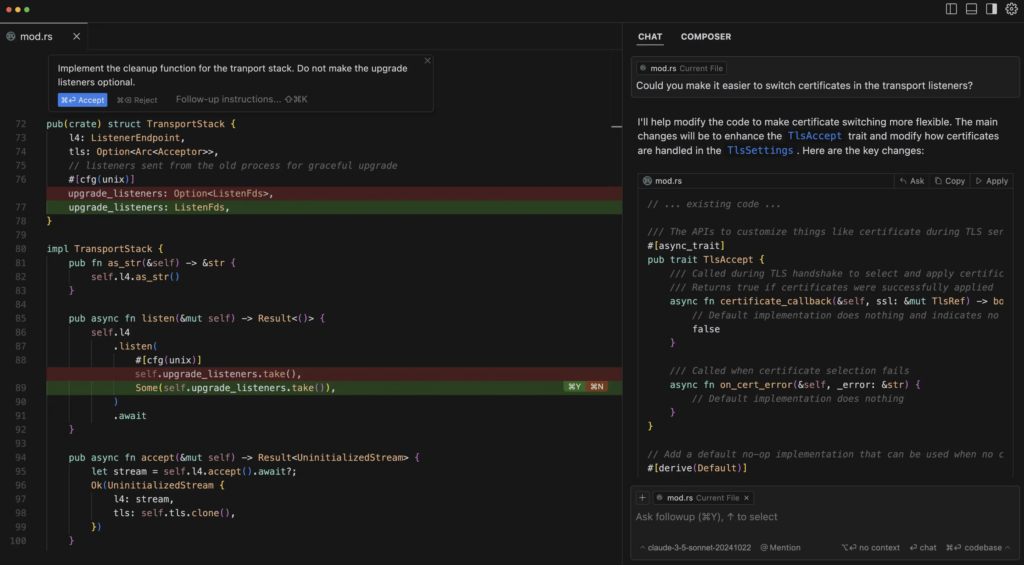
Best for: Developers and engineering teams looking for an AI-enhanced code editor for full-stack development, refactoring, and debugging.
Pricing: Starts at $20/month (free plan available).
Cursor AI is an AI-powered code editor built on VS Code. It boosts developer productivity by embedding AI features directly into the coding environment.
You’ll get a robust development experience with tools like context-aware code completion, natural language commands, and multi-file editing – all designed to streamline your workflow.
Its real-time collaboration tools make it practical for teams, while terminal integration adds flexibility for developers working with command-line workflows.
Key features:
- AI-powered code completion – delivers intelligent, context-aware suggestions and multi-line code generation.
- Natural language commands – lets you write or modify code using plain English instructions.
- Multi-file editing – allows efficient, simultaneous refactoring across multiple files.
- Terminal integration – converts plain-language prompts into usable terminal commands.
Pros:
- Improves coding speed and accuracy with AI-driven suggestions.
- Identifies and recommends fixes for bugs using codebase-wide analysis.
- Offers a privacy mode and local processing to keep sensitive code secure.
- Familiar interface for VS Code users, reducing onboarding time.
Cons:
- Available only as a desktop app for Windows, macOS, and Linux.
- Resource-heavy features may affect performance on older machines.
- Occasionally generates inaccurate or irrelevant code in complex scenarios.
Conclusion
In this article, we explored the top alternatives to v0 by Vercel. Each platform offers a unique approach to building and deploying modern web apps, whether as a solo founder, designer, or part of a development team.
Here are three standout options worth your attention:
- Hostinger Horizons – best for beginners and small teams who want an all-in-one solution with AI-assisted app generation, built-in hosting, and quick deployment.
- Netlify – a great choice for frontend-focused teams building Jamstack sites, thanks to its automated builds, serverless functions, and global CDN.
- Motiff – ideal for UI/UX designers and product teams looking for AI-powered design tools with seamless developer handoff and real-time collaboration.
Before choosing the right tool, consider your technical skills, project scope, collaboration needs, and budget.
Whether you’re starting from a prompt or a prototype, the best alternative is the one that fits your workflow and helps you launch faster with fewer roadblocks.
v0 alternatives FAQ
What are the other Vercel products?
Vercel products include frontend hosting, analytics, edge functions, and serverless storage. It’s known for its tight integration with Next.js, making it easy to deploy high-performance web apps. Developers can also use Image Optimization, Preview Deployments, and Edge Middleware to streamline workflows.
What are free v0 alternatives?
Free v0 alternatives include Hostinger Horizons, Replit, Netlify, and Motiff – all offer free plans with usage limits. They provide AI-assisted development, design tools, or hosting, making them ideal for prototyping, testing ideas, or experimenting with projects before moving to a paid plan.
What are v0 open-source alternatives?
v0 open-source alternatives are limited, as most platforms like Hostinger Horizons, Bubble.io, and GitHub Copilot are proprietary. Developers seeking open-source options can try Supabase for backend services, Appsmith for internal tools, and Payload CMS for content management.

